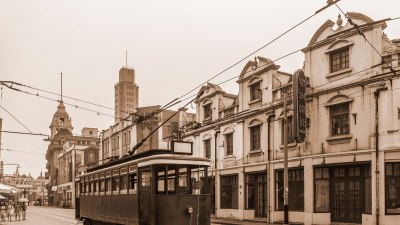The Most Bizarre and Unique Public Transport Systems
Explore some of the world's most unique and bizarre public transport systems that redefine urban mobility.

Public transport is a vital part of urban infrastructure, allowing millions of people to navigate cities efficiently. While many cities have traditional systems like buses and subways, some transportation networks stand out due to their unique, bizarre, or creative approaches. Here, we explore some of the most unusual and intriguing public transport systems from around the globe.
Trams of Croydon, UK
One of the most unassuming public transport systems is that of Croydon, a borough in Greater London. Croydon's tram system, known as Tramlink, is remarkable not just for its efficient service but also for its blend of traditional tram services with the local culture and architecture. Opened in 2000, the system connects various suburbs to central Croydon and offers spectacular sights along the journey, including snippets of the local life and culture. Its design encourages smoothly integrated transfers to buses and trains, making it a peculiar hybrid of modern transport fusion.
The Floating Bridge of Cowes, Isle of Wight
In Cowes, Isle of Wight, the floating bridge operates as a ferry that connects the town with the mainland. What makes this transport system particularly bizarre is that it is a chain-operated ferry that moves people and vehicles across a stretch of water. This unique mode of public transport has been in use since 1859. Visitors often marvel at how the platform remains buoyant while making the short crossing. A ride on the floating bridge not only serves as a means of transport but also provides picturesque views of the Solent, making it a memorable experience.
The Cable Cars of Ngong Ping, Hong Kong
In Hong Kong, the Ngong Ping 360 cable car system offers not only an exhilarating ride but also breathtaking views of Lantau Island. The cable car stretches across 5.7 kilometers and gives passengers a bird's-eye perspective of the surrounding mountainous terrain and the South China Sea. What adds to its uniqueness is the glass-bottomed cabins that allow for an even more exhilarating experience, looking straight down to the lush green hills below. The cable cars contribute not just to public transport but also act as a thrilling tourist attraction, connecting the Tung Chung MTR station to the Ngong Ping village, home to attractions such as the Tian Tan Buddha.
Funiculars of Pittsburgh, USA
Pittsburgh is known for its hilly terrain, and its solution to this challenge is the funicular, specifically the Duquesne Incline and the Monongahela Incline. These historic cable cars operate on steep slopes and offer remarkable views of the skyline and rivers. Constructed in the late 19th century, these funiculars have become a vital part of the city’s transport landscape, providing a quick connection between the city's hilly neighborhoods and downtown Pittsburgh. Their charming vintage design and operational mechanics are a favorite among both locals and tourists, showcasing a unique transport era.
The Elvia Trolleybus of Feira de Santana, Brazil
Feira de Santana in Brazil boasts a unique public transportation system that relies on trolleybuses powered by overhead wires. What makes this system especially unique is that it's one of the few that operates entirely on solar power. This sustainable approach to transport showcases the city's commitment to eco-friendly travel options. Riders can expect a comfortable and quiet journey, with the added benefit of lower emissions compared to traditional diesel buses. The colorful trolleybuses are a common sight throughout the city, signifying a forward-thinking approach to urban mobility.
Monorails of Tokyo, Japan
The Yurikamome and Tokyo Monorail systems are two fascinating examples of monorail technology that provide an effective means of transportation while offering stunning views of the cityscape. The Yurikamome travels over the Rainbow Bridge and through Odaiba, making it a popular choice for tourists wanting picturesque views of Tokyo Bay. The Tokyo Monorail, connecting Haneda Airport to the city, sails over various scenic landscapes, giving passengers a unique aerial perspective of the metropolis. Both systems represent Japan’s commitment to innovative transport technology, seamlessly blending into the urban environment.
Tricycle Taxis of the Philippines
In the Philippines, the use of tricycle taxis provides a vibrantly colorful and unique means of transport. These motorbike-drawn sidecars are common in both urban and rural areas, allowing for flexible and often entertaining local transport. The tricycles often feature colorful designs, reflecting local culture and character. Their small size allows them to weave through traffic, making them an efficient choice for navigating congested streets. Passengers are treated to a local experience with every ride, making the tricycle not just a means of transport but also a slice of Philippine culture.
Rickshaws of India
Rickshaws, whether cycle or motor-powered, are an integral part of India's urban transport. These three-wheeled vehicles are not just a common sight like standard taxis or auto-rickshaws but also represent a rich history and culture. Offering a quirky and personalized means of traversing the busy streets, they often come in vibrant colors and styles, resonating with Indian traditions. The low-cost fares make them accessible to everyone, and their maneuverability helps in managing the heavy city traffic. Their charm and unique operation serve as a delightful encounter for residents and tourists alike.
The Light Rail of Portland, Oregon
The MAX Light Rail system in Portland, Oregon is notable not just for its efficiency but also for its unique integration with the city’s bike-sharing program. This public transport system allows passengers to bring their bikes onto the trains, promoting a greener method of urban mobility. The trains themselves are a delight to ride, with specially designed cars that accommodate cyclists. The system is often praised for its cleanliness and frequent service, making it a crucial component of Portland's eco-friendly transportation ethos.
The People Mover of Detroit, Michigan
Detroit's People Mover is an elevated automated transit system offering a unique view of the city. Operating in a loop around Detroit’s downtown, this driverless system connects key points of interest, including business districts and sporting venues. Its compact design and elevated tracks provide an unobstructed view of the bustling urban environment. Passengers enjoy a convenient and quirky travel experience above the city streets, making it an unusual yet essential transport option for locals and tourists alike.
Solar-Powered Buses of Shenzhen, China
Shenzhen is leading the charge in electrifying public transport with its entirely solar-powered bus fleet. These eco-friendly vehicles operate across the city, offering a sustainable alternative to traditional diesel-powered buses. Not only does this reduce greenhouse gas emissions significantly, but it also provides residents with a quieter travel experience. The solar buses run on a well-planned schedule, connecting various parts of the city efficiently while emphasizing sustainability in public transport. Shenzhen's initiative sets an example for cities around the world to embrace cleaner transportation options.
The Bandiac Trolleybus of Ethiopia
In Ethiopia, particularly in Addis Ababa, the Bandiac trolleybus system provides a unique transport solution for navigating the urban landscape. This system uses overhead electric lines to power its buses, presenting a cleaner alternative for urban travel. The trolleybus network has been a game-changer for many residents, reducing the heavy reliance on matatus (mini-buses) and offering a more organized transit system. Its introduction marks a significant move towards enhancing public transport efficiency in one of Africa’s fastest-developing cities.
The world is full of bizarre and unique public transport systems that defy conventional norms and enhance urban mobility in imaginative ways. From the floating bridges of Cowes to the solar-powered buses of Shenzhen, these transport solutions reflect local culture, geography, and technological advancements. As cities continue to evolve and grow, these unique public transport systems serve as reminders of how creativity can solve urban challenges, offering effective and enjoyable travel options for residents and visitors alike.











